
Mars Habitat Excursions: As we peer into the possibilities of interplanetary travel, Mars remains a focal point of human curiosity and ambition. The concept of Mars habitats is no longer a matter of science fiction but a tangible goal that numerous space agencies and private entities are fervently working towards. Establishing a Mars habitat entails creating a liveable environment that can support human life on the Red Planet’s harsh terrain, involving intricate life support systems, sustainable living quarters, and protective space suits designed for Martian explorations.
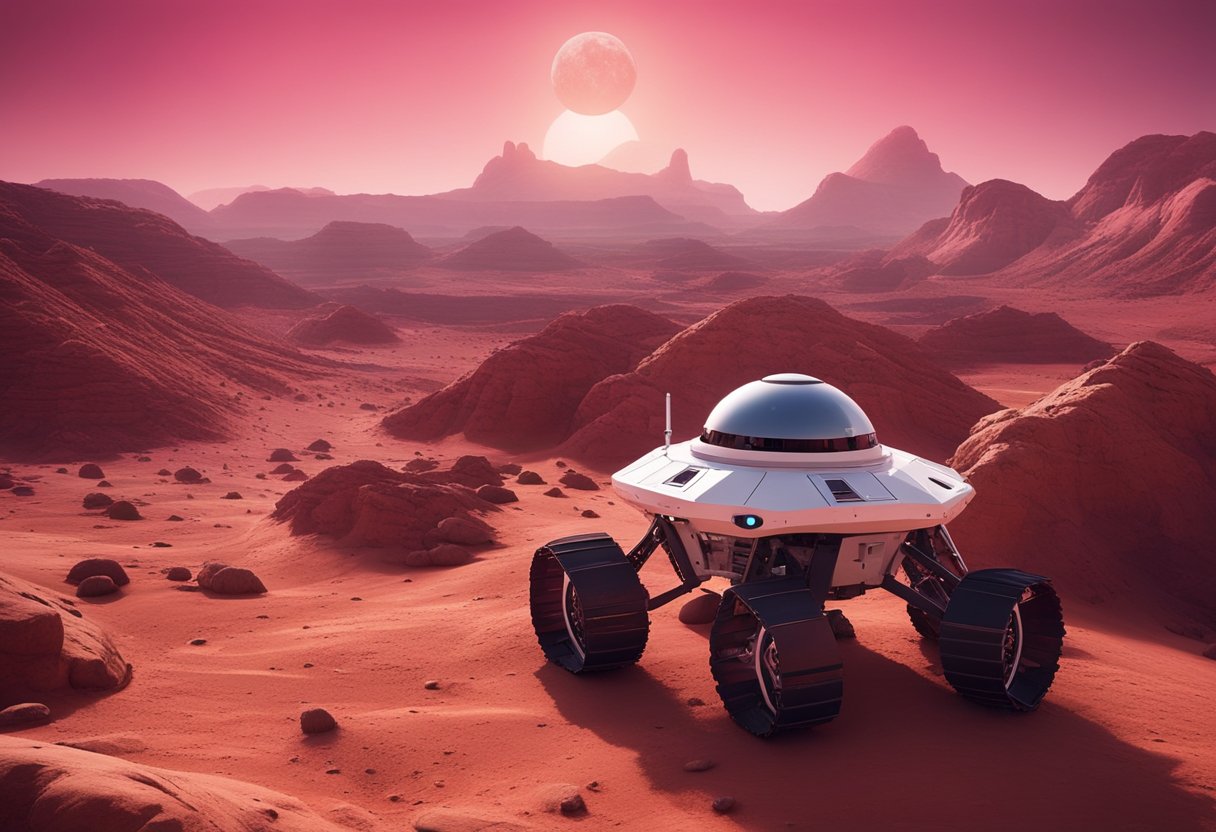
Through diligent effort and international collaboration, such as partnerships with NASA, advances in technology and understanding are addressing the challenges of living and working on Mars. These habitats are envisioned to serve not only as accommodations but also as advanced laboratories where scientific research and experiments can take place. Connectivity back to Earth, robust safety measures, thorough preparation for excursions outside the habitat, and psychological support systems are all part of ensuring the success of these missions.
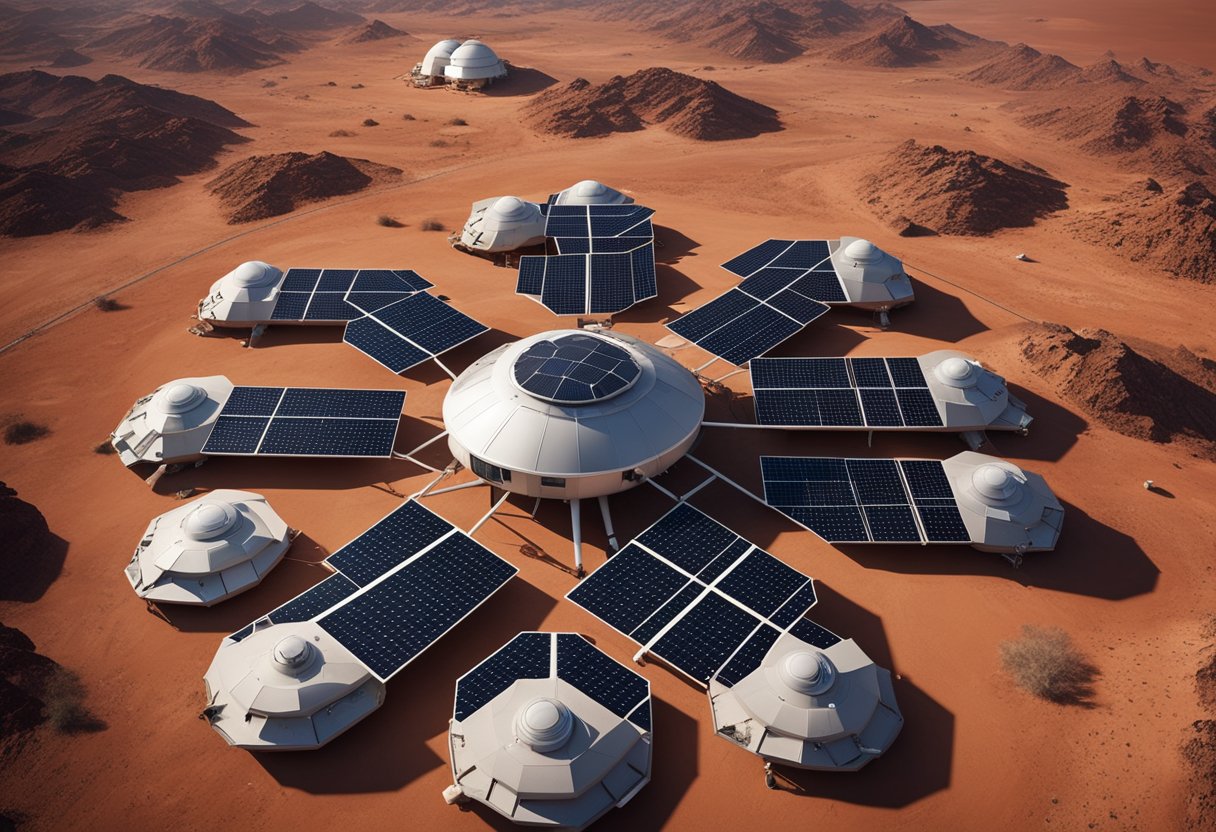
As we explore the viability of a sustained human presence on the Martian surface, the design and construction of habitable structures are paramount. Below, we outline key aspects of habitat design and materials that are currently shaping our approach to living on Mars.
The Mars habitat is conceived to be a robust structure capable of supporting human life in the extreme conditions of the Martian environment. Our design objectives include ensuring a sealed environment to protect against the planet’s thin atmosphere and harsh temperature fluctuations. We are incorporating advanced technologies like 3D-printed elements utilising in-situ resources to streamline the construction process. The habitat’s dome-shaped design is favoured for its ability to efficiently distribute the pressure and mitigate radiation exposure.
Specific initiatives like NASA’s CHAPEA and the Mars Dune Alpha project are focused on simulating Mars surface living conditions to prepare for future missions. These include year-long stays in isolated structures to study crew health and performance in a controlled, Earth-based environment.
The structural integrity of habitats on the Martian surface requires innovative materials that can be produced on Mars, reducing the need for transport from Earth. One promising concept is the utilisation of a brick-making machine that can process the Martian regolith into sturdy construction bricks.
Solar-powered systems are integral to the design, ensuring a sustainable and reliable energy supply. This is particularly critical considering the challenges of Mars’s weaker sunlight. For the interior, we contemplate the use of high-efficiency materials capable of maintaining a habitable atmosphere, protecting crews from solar radiation and extreme external temperatures.
In preparing for Mars habitat excursions, our foremost consideration is maintaining systems that support human life. We focus on critical components such as atmosphere management and water recycling to ensure a habitable environment.
Air Composition: We strive to maintain an Earth-like atmosphere within the Mars habitat. This involves a careful balance of oxygen, nitrogen, and trace gases to sustain life. CO2 Scrubbing: To manage carbon dioxide levels, we employ advanced filtration systems that remove CO2 from the air, ensuring the safety and comfort of the crew.
Airlock Efficiency: To prevent atmosphere loss, airlocks between the Mars habitat’s interior and the Martian environment are meticulously controlled. They operate with precision to minimise air mixture with the thin Martian atmosphere.
Water Recovery: Utilising state-of-the-art water recovery systems helps us to recycle and purify water from various sources, including humidity from the air and astronaut’s waste water, to reduce the need for water supplies from Earth.
Water Usage: Water is precious on Mars, thus we emphasise strict usage policies and innovative technologies for water filtration and dispensation to support life without excessive consumption. Our systems ensure clean water is available for drinking, cooking, and hygiene.

In anticipation of mars habitat excursions, we’ve seen significant strides in the development of spacesuit technology. These advancements specifically target the unique challenges posed by the Martian environment, ensuring astronaut safety and mobility during surface operations.
Our understanding of spacesuits as merely bulky, life-preserving enclosures has evolved dramatically. The latest designs are tailored to address the Martian environment’s challenges, such as extreme temperature variations, toxic soil, and the need for substantial mobility.
In partnership with agencies like NASA and private entities, future spacesuit iterations will continue to advance. Our collaborations, alongside companies like Axiom Space and Collins Aerospace, are paving the way for the use of these suits not only on the moon but also for the forthcoming Mars missions, as noted in articles on Space.com and Scientific American.
Providing protective gear fit for the Martian terrain involves ongoing research and development. We are also preparing for the eventual wear and testing of materials on Mars, as exemplified by NASA’s Perseverance Rover, which has already taken the first samples of spacesuit material to the planet, showcased on NASA’s official site. This is not only a significant step forward in our readying for human landings but also a leap towards sustainable human presence outside Earth.
Our engagement in these efforts extends to educational initiatives. We encourage students to design and construct wearable model spacesuits to explore Mars’s surface and provide resources and guidance to foster the next generation of suit designers, as part of NASA’s educational outreach detailed in their Designing Spacesuits for Mars program. These pursuits ensure that we remain at the forefront of preparing humanity for life and work on distant worlds.
For the curious and the bold looking towards the stars, we invite you to explore and stay informed about the future of space travel, including advances in spacesuits and, by extension, our dreams of space tourism, at SpaceVoyageVentures.com.
NASA’s exploration of Mars involves extensive partnerships, weaving a fabric of international and private sector cooperation that is crucial for the success and sustainability of these missions.
We are committed to fostering international collaboration through joint ventures such as the Artemis programme, which paves the way for a sustained human presence on the Moon and serves as a stepping stone for future Mars exploration. The Johnson Space Center plays a pivotal role in this endeavour, coordinating efforts among international space agencies to pool resources, expertise, and technology. Collaborative efforts are evident in habitat simulations, such as the recent selection of a crew for a simulation at the Johnson Space Center to live and work in conditions akin to those on Mars.
We also place high importance on incorporating the private sector’s innovative approaches and resources. NASA’s selection of six companies to develop ground prototypes for deep space habitats is a testament to our reliance on private sector ingenuity. Working alongside NASA-funded entities, these companies help in designing and testing structures, like the Mars Dune Alpha, that replicate a realistic Mars habitat. Such partnerships not only accelerate technological development but also open avenues for space tourism, providing public insights into the possibilities of future interplanetary travel.
As we prepare for sustained life on Mars, we focus not only on the technological challenges but also on the day-to-day experiences and health needs of crew members.
Our daily routines on Mars are meticulously planned to maximise efficiency and ensure the safety of all astronauts. Upon waking, crew members engage in a series of checks and communication activities with Earth’s mission control. Breakfast is followed by a briefing of the day’s tasks, which may include:
Every activity is designed to contribute to our understanding of Mars, prepare for future colonisation, and ensure astronauts’ well-being.
Physical activity is crucial for maintaining physical and mental health. Our exercise regimen includes:
| Equipment | Duration | Frequency |
|---|---|---|
| Treadmill | 30 mins | Daily |
| Stationary Bike | 20 mins | Daily |
| Resistance Band | 15 mins | Daily |
Mental health is equally important, as living in the confined and isolated environment of a Martian habitat can induce considerable mental stress. Regular communication with family and psychological support are critical, as is designated leisure time for reading or relaxing. Schedules are crafted to balance workloads and reduce monotony, with social activities designed for team bonding and morale.
Structured exercise routines combat muscle atrophy and bone density loss, while various recreational activities mitigate the effects of mental strain. We’ve learned that the treadmill is particularly valued not just for its cardiovascular benefits but also for a semblance of normalcy it offers in a foreign world.
Crew health and performance are monitored through wearables that provide real-time data on vital signs, which are crucial for immediate medical interventions if needed. Our commitment to a comprehensive health and exercise programme underscores our dedication to the success of Martian missions, both for the immediate goals of exploration and the long-term objective of establishing a thriving human presence on Mars.
In our ongoing efforts to understand and conquer the challenges of Mars colonization, scientific research and experiments form the bedrock of our mission. We conduct rigorous geological studies, biological experimentation, and test cutting-edge technology to pave the way for future human habitation.
Mars presents a diverse geological landscape ripe for study. We systematically collect and analyse soil and rock samples to decode the planet’s past environments. Insights from these investigations help us understand the presence of water in Mars’ history, as noted through the confirmation of an ancient lake, and formulate predictions about its geological evolution.
Exploring the potential for life on Mars, our scientists pioneer in-situ biological experiments. Within controlled greenhouses, we investigate plant growth, replicating the Martian climate, and monitor how reduced gravity and different atmospheric compositions affect their development. Our volunteers’ first-hand experiences in habitat simulations contribute to our understanding of human adaptability in extraterrestrial environments.
Our journey encompasses developing and testing emergent technologies crucial for space exploration. This involves trials of life-support systems, habitat constructions like the 3D-printed Mars Dune Alpha, and suits designed to weather the harsh Martian terrain. Through these simulation habitats, we not only rehearse extravehicular activities but also enhance our technological readiness for prolonged stays on Mars.

In establishing a habitat on Mars, we recognise the importance of robust communications and reliable connectivity. Not only are these critical for data transfer and command protocols, but they also underpin the mental well-being of our crew through interpersonal communication.
Efficient communication between Mars and Earth is challenged by the communication delay ranging from 3 to 22 minutes. This latency affects both the real-time exchange of information and the strategic planning of habitat excursions. For mission-critical and time-sensitive operations, we liaise with NASA’s Deep Space Network for high-rate data links, essential for both forward and return communications.
The data transfer process is carefully orchestrated to cope with these delays, utilising a mix of high-gain and ultra-high-frequency antennas. We optimise the use of overhead orbiters as relay stations, enabling a steady flow of scientific and engineering telemetry back to mission control.
For interpersonal communication within the Mars habitat, we install state-of-the-art communication systems to simulate a sense of proximity akin to Earth conditions. Given the psychological distance imposed by interplanetary space, we foster an environment where astronauts can easily converse and share experiences, maintaining morale and team cohesion.
Conversations with loved ones and Earth-based teams are scheduled during windows when Earth and Mars align favourably, minimising the delay as much as possible. Adaptations in our communication protocols ensure that messages relayed between the crew and mission control maintain a thread of continuity, despite the inherent delays.
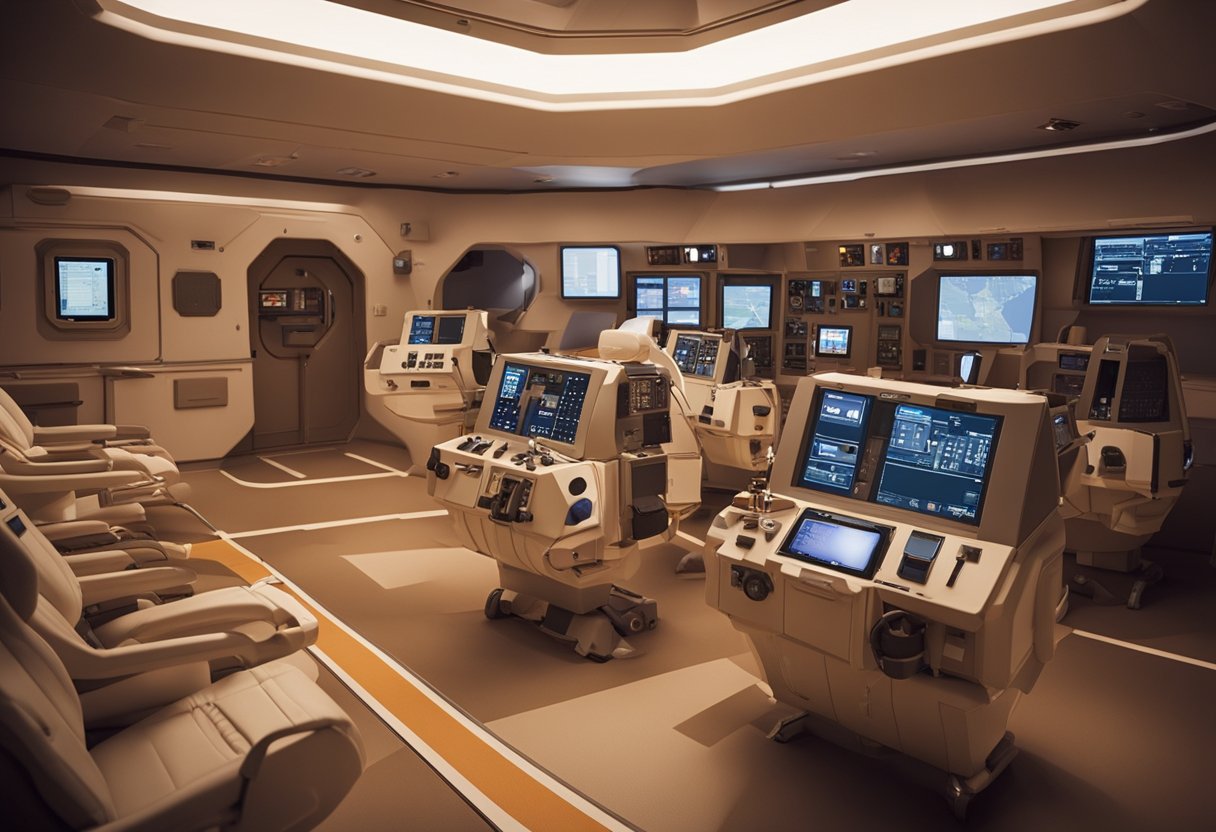
In constructing habitats on Mars, we focus meticulously on safety and emergency protocols to ensure crew health and performance under various scenarios. Our exploration analogs draw from rigorous simulations and real-world testing to prepare for unforeseen circumstances.
Maintaining the structural integrity and functionality of a Mars habitat is crucial for safeguarding the crew. We employ a proactive maintenance strategy, which includes regular checks and servicing of critical systems to prevent equipment failure. In the eventuality of a breakdown, we have redundant systems in place to ensure there’s no compromise in safety. Additionally, we store replacement parts and have repair protocols ready so that we can swiftly address any issues that arise, minimising any potential risks to the habitat and crew.
Our medical bay is equipped to handle a wide range of medical issues, providing comprehensive medical care akin to Earth standards within the constraints of a Martian environment. We have a telemedicine system for real-time consultation with experts on Earth. Our medical inventory includes an array of medications, diagnostic tools, and surgical equipment to address potential health concerns.
Medical Inventory:
Training:
Our approach combines diligent maintenance and state-of-the-art medical facilities to ensure expeditions on Mars are executed with the utmost attention to safety.
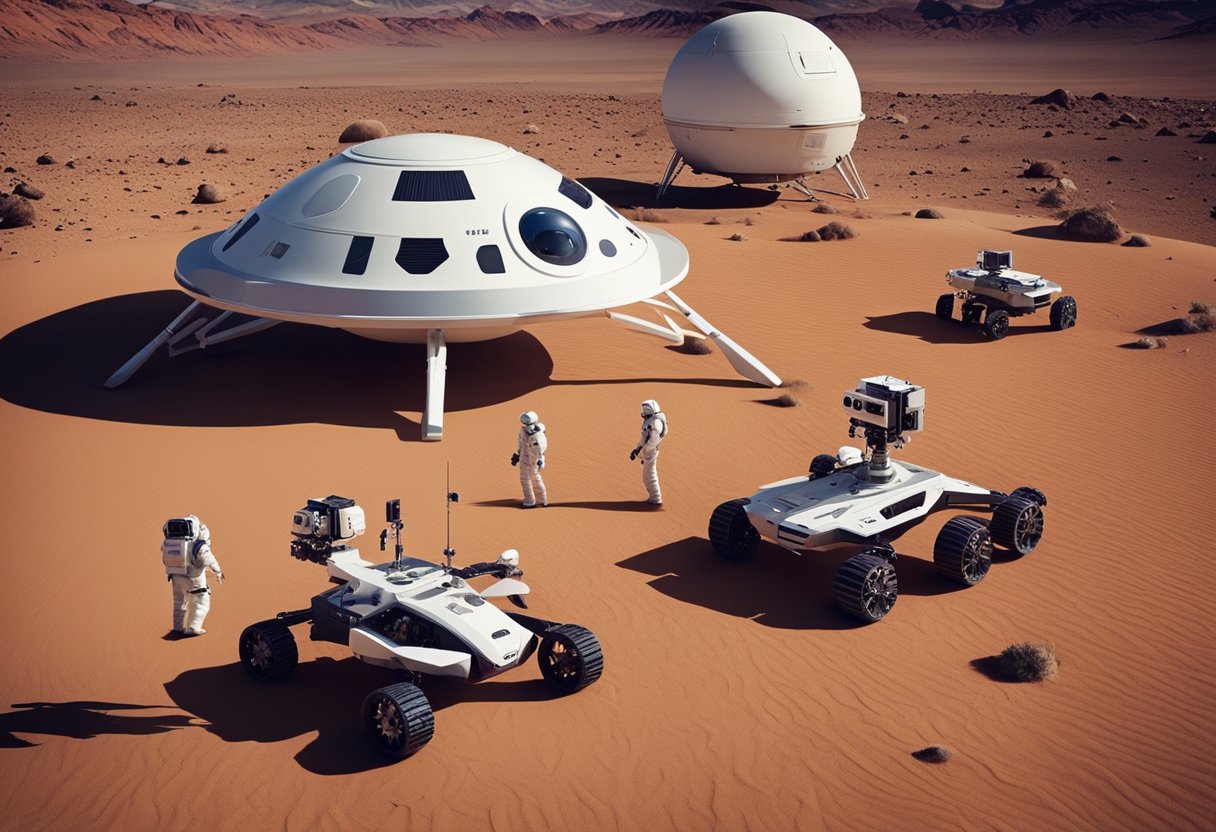
As we anticipate the formidable challenge of exploring the red planet, rigorous preparation is paramount. To ready ourselves for the harsh conditions on Mars and the complexity of missions ahead, our focus is honed on simulation and training, complemented by thorough planning for extra-vehicular activities.
Immersive and extensive training in environments that closely mimic Martian conditions is vital. We leverage advanced virtual reality systems to acquaint ourselves with the red planet’s terrain. Working within a 3D-printed habitat in Texas, volunteers experience living as they would on Mars, providing insights into the psychological and practical challenges of prolonged isolation. Our simulated Mars habitat acts as a sandbox where we refine our survival and operational strategies.
Key Components of Simulation:
For EVAs, or spacewalks, meticulous planning is crucial due to the thin Martian atmosphere and lower gravity. Practice sessions in simulated Martian soil environments teach us how to manage our suits and movement on the Martian surface. Each EVA is a carefully choreographed operation, designed to maximise the scientific return while ensuring astronaut safety.
EVA Essentials:
In both training and actual EVAs, our mantra is precision, safety, and scientific curiosity as we prepare for the eventual human exploration of Mars.
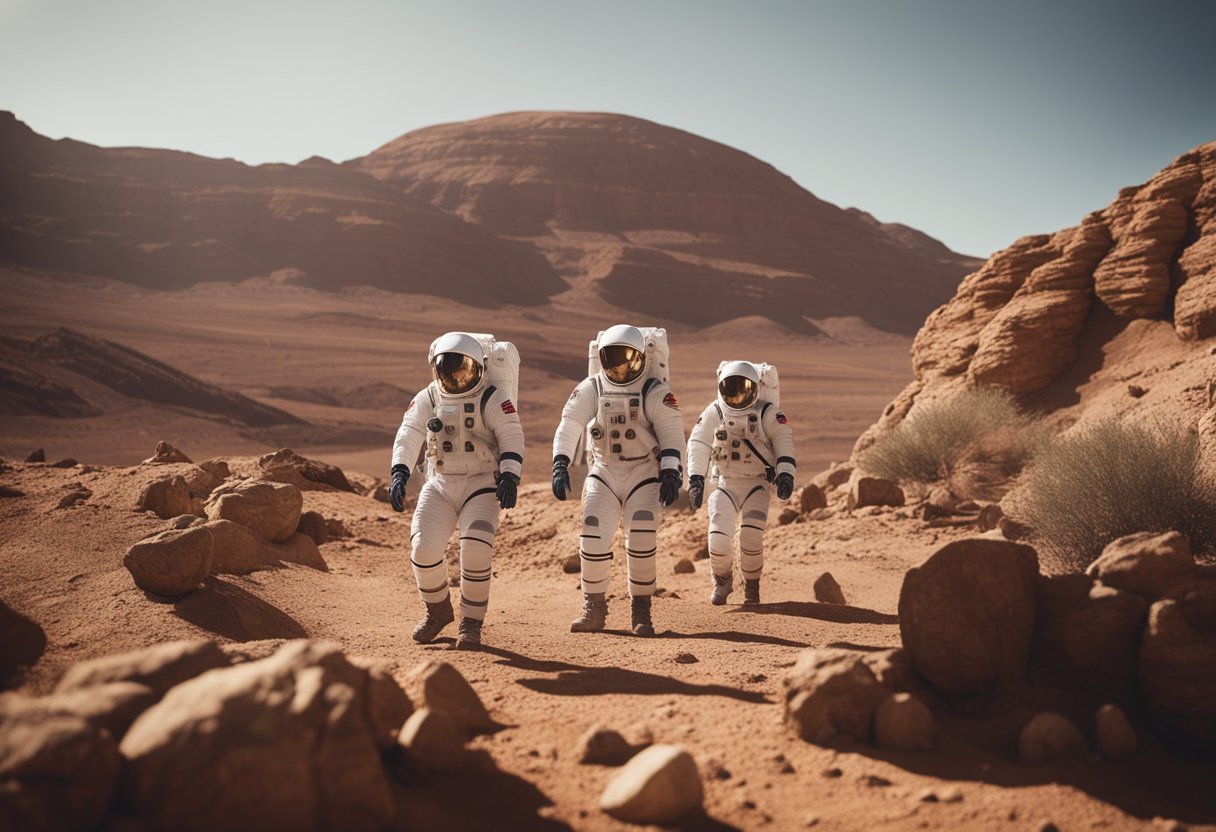
While embarking on Martian expeditions, we must consider the psychological stressors unique to this environment. Our crew’s mental well-being is as critical as their physical health, given the vast distances from Earth’s social support systems.
Isolation in the Martian habitat poses significant challenges. With potential delays in communication reaching up to 22 minutes, the feeling of separation can be profound. It’s vital to implement structures for managing such isolation. Regular contact with loved ones on Earth through audio or written messages, as seen in prolonged space missions, could mitigate feelings of loneliness. Confinement within the habitat can lead to cabin fever. We’ve observed this in studies on Earth, where individuals demonstrate a need for personal space and designated areas for social activities.
Resource limitation is another aspect of space habitation that cannot be overlooked. Limited access to necessities and comfort items could lead to heightened stress levels. Ensuring an adequate supply of resources and implementing strict usage protocols becomes essential to prevent tensions within the crew.
Our approach to behavioral health centres on preemptive and ongoing strategies. Daily routines, including work schedules and leisure activities, are tailored to instil a sense of normality. For instance, incorporating Earth-like day-night cycles will help regulate sleep and mitigate disturbed sleep cycles.
In stressful situations, it’s our protocol to employ stress-reduction techniques such as guided meditation and deep-breathing exercises. Understanding that every individual reacts differently under pressure, our support system includes real-time psychological support, and if needed, we are prepared with telepsychiatry services.
For a more in-depth understanding of the complexities of a Martian lifestyle, we refer to resources such as SpaceVoyageVentures.com, which sheds light on the psychological aspects of space travel. This preparation underscores our commitment to the well-being of the pioneers who will call Mars home.
In this section, we’ll examine how current lunar missions pave the way for Martian exploration, and what to anticipate as we approach the 2030s, a pivotal decade for human visits to the Red Planet.
The Artemis programme—a series of missions focused on the Moon—is our launchpad for deeper space exploration. Our experience from these missions will inform our journey to Mars. For instance, living on the lunar Gateway gives us insight into life in deep space, which is essential for the long-duration missions to Mars. Enhancing technology and testing human endurance in the Artemis missions directly contributes to the robustness and safety of future voyages to Mars.
Looking ahead to the 2030s, we anticipate a burgeoning era of human exploration on Mars. Our involvement in habitability studies, such as those conducted in Earth-based Mars habitats, helps us prepare for extended stays on the Martian surface. The data collected regarding Martian temperatures and atmosphere composition is crucial for designing life-support systems. Our future missions may possibly include SpaceVoyageVentures.com as a resource for space enthusiasts who aim to follow or even participate in early space tourism ventures to Mars, should such remarkable opportunities become nearly available.
As we continue to lay the groundwork, National Geographic and similar outlets will likely document these historic steps, bringing the wonders of space travel to living rooms worldwide. Our goal remains clear: to secure a foothold in space for humanity, and Mars is the next chapter in that ongoing story.
In this section, we address some of the most commonly asked queries about Mars habitats and how they pave the way for future manned missions to the Red Planet.
Mars habitats are engineered to create a liveable environment in a hostile landscape. They utilise advanced life support systems that provide oxygen, water, and temperature control, while shielding inhabitants from Mars’ extreme temperatures and radiation.
The prevailing goal of these experiments is to understand how to sustain human life on Mars long-term. This includes testing the viability of closed-loop life support systems and developing strategies for self-sufficiency in food production and resource utilisation.
Mars isolation experiments, such as those at the Mars Society’s research stations, have revealed psychological and group dynamics challenges, the importance of reliable communication with Earth, and the need for physical and mental health maintenance in isolation.
Engineers contend with Mars’ reduced gravity, thin atmosphere, and lack of building materials present on Earth. They are exploring the use of in-situ resource use (ISRU) technology to construct habitats from Martian soil.
NASA’s Mars Habitat Project is focused on developing sustainable living quarters using materials and technologies that can function in the Martian environment and support astronauts’ well-being for extended periods.
People can become involved by supporting research through educational outreach, participating in citizen science programmes, or even contributing to crowdsourced projects aimed at solving specific problems related to living on Mars.